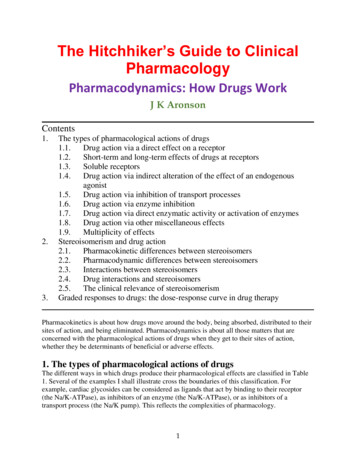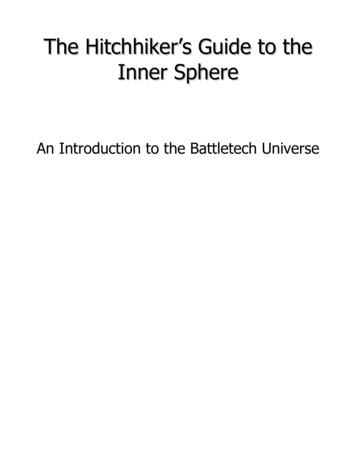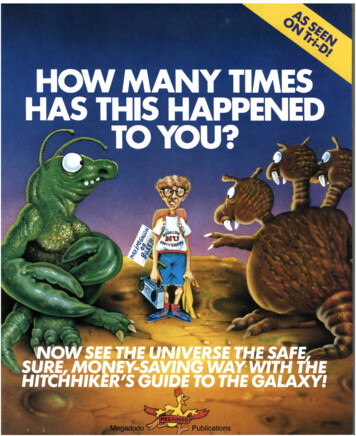
Transcription
The Hitchhiker’s Guide to ClinicalPharmacologyPharmacodynamics: How Drugs WorkJ K AronsonContents1.2.3.The types of pharmacological actions of drugs1.1.Drug action via a direct effect on a receptor1.2.Short-term and long-term effects of drugs at receptors1.3.Soluble receptors1.4.Drug action via indirect alteration of the effect of an endogenousagonist1.5.Drug action via inhibition of transport processes1.6.Drug action via enzyme inhibition1.7.Drug action via direct enzymatic activity or activation of enzymes1.8.Drug action via other miscellaneous effects1.9.Multiplicity of effectsStereoisomerism and drug action2.1.Pharmacokinetic differences between stereoisomers2.2.Pharmacodynamic differences between stereoisomers2.3.Interactions between stereoisomers2.4.Drug interactions and stereoisomers2.5.The clinical relevance of stereoisomerismGraded responses to drugs: the dose-response curve in drug therapyPharmacokinetics is about how drugs move around the body, being absorbed, distributed to theirsites of action, and being eliminated. Pharmacodynamics is about all those matters that areconcerned with the pharmacological actions of drugs when they get to their sites of action,whether they be determinants of beneficial or adverse effects.1. The types of pharmacological actions of drugsThe different ways in which drugs produce their pharmacological effects are classified in Table1. Several of the examples I shall illustrate cross the boundaries of this classification. Forexample, cardiac glycosides can be considered as ligands that act by binding to their receptor(the Na/K-ATPase), as inhibitors of an enzyme (the Na/K-ATPase), or as inhibitors of atransport process (the Na/K pump). This reflects the complexities of pharmacology.1
Table 1. The types of pharmacological actions of drugs1.2.3.4.5.6.Drug action via a receptor(a) Agonists(b) Antagonists(c) Partial agonists(d) Inverse agonistsDrug action via indirect alteration of the effect of an endogenous agonist(a) Physiological antagonism(b) Increase in endogenous release(c) Inhibition of endogenous re-uptake(d) Inhibition of endogenous metabolism(e) Prevention of endogenous releaseDrug action via the inhibition of transport processesDrug action via enzyme inhibitionDrug action via enzymatic action or activation of enzyme activityDrug action via other miscellaneous effects(a) Chelating agents(b) Osmotic diuretics(c) Volatile general anaesthetics(d) Replacement drugs1.1. Drug action via a direct effect on a receptorReceptors are specific proteins, situated either in cell membranes or, in some cases, in thecellular cytoplasm. For each type of receptor, there is a specific group of drugs or endogenoussubstances (known as ligands) that are capable of binding to the receptor, producing apharmacological effect. Most receptors are located on the cell surface. However, some drugs acton intracellular receptors; these include corticosteroids, which act on cytoplasmic steroidreceptors, and the thiazolidinediones (such as pioglitazone), which activate peroxisomeproliferator-activated receptor gamma (PPARy ), a nuclear receptor involved in the expression ofgenes involved in lipid metabolism and insulin sensitivity. The important receptor systems andtheir ligands are listed in Table 2.There are four types of ligand that act by binding to a cell surface receptor, agonists,antagonists, partial agonists, and inverse agonists (Figure 1).(a) AgonistsLigand s that bind to a receptor and produce an appropriate response are called agonists. Forexample, the catecholamine adrenaline is an agonist at β-adrenoceptors. When it binds to βadrenoceptors in the heart, it increases the heart rate.(b) AntagonistsLigands that prevent an agonist from binding to a receptor and thus prevent its effects are calledantagonists. Antagonists do not themselves have any pharmacological actions mediated byreceptors. For example, propranolol, a β-adrenoceptor antagonist, binds to β-adrenoceptors in theheart and prevents catecholamine-induced tachycardia (for example in response to exercise).However, in the absence of an agonist propranolol has no effect via adrenoceptors.2
Table 2. Examples of important receptors, their agonists and antagonistsReceptor typeAdrenoceptorsSubtypeα/βSite(s) in the stsLabetalolα1Pupillary dilator muscleVascular smooth muscleDopamine (highdoses) Phenylephrineα2CNSPresynaptic anololβ1/β2β1CNSHeartDobutamineDopamine (moderatedoses)β2Pancreatic isletsSmooth muscle(bronchiolar, noceptorsMuscarinicTissues innervated byparasympathetic nervesAcetylcholine andanalogues (e.g.carbachol,bethanecol)NicotinicNeuromuscular junctionPostganglionic cells ingangliaAcetylcholine andsome analogues (e.g.carbachol)DopaminereceptorsVariousCNSRenal vasculatureApomorphineBromocriptineDopamine (low pinesGABABCNS artanAtropine and analoguesDisopyramideOrphenadrinePirenzepine (M1 selective)QuinidineTricyclic antidepressantsTrihexyphenidylAminoglycoside antibioticsGanglion-blocking drugsNeuromuscular-blocking drugsQuinidineButyrophenones (e.g. haloperidol)Domperidone (D2)MetoclopramidePhenothiazines (e.g.chlorpromazine)Thioxanthenes (e.g. flupenthixol)BicuculineBaclofen
HistaminereceptorsH1Smooth muscle(bronchiolar, e.g. promethazine, ceptorsVariousCNSVascular smooth muscleGastrointestinal tract5HTLeukotrienereceptorsCysLT1Bronchial and vascularsmooth zatidineMethysergide (5HT)Sumatriptan (5HT1D)Ketanserin (5HT2)Ondansetron (5HT3)MontelukastZafirlukastOpioidreceptorsμ, δ, and κBiliary tractCNSGastrointestinal tractGenitourinary tractPupillary muscleVascular smooth muscleVasopressinreceptorsV1A, V1b ,and V2Endorphins andenkelphalinsMorphine andanalogues (μagonists)Non-opioid narcotics(μ agonists, e.g.pentazocine)Vasopressin (ADH)Buprenorphine (κ) (partialagonist)Methylnaltrexone (δ)Nalbuphine (μ, δ, and κ)Nalmefene (μ and κ)Nalorphine (μ)Naloxone (δ and κ)Naltrexone (μ, δ, and κ)Conivaptan (V1A and V2)Nelivaptan (V1b)Tolvaptan (V2)The complexity of some drugs is illustrated by the several actions of beta-adrenoceptorantagonists (beta-blockers), as shown in Table 3.Table 3. Differences in the actions of some beta-adrenoceptor antagonistsCardioPartial Membraneselectivityagonist stabilizingPeripheralDrug(i.e. β1 β2) activity activityvasodilatationAtenolol –––Bisoprolol –– Carvedilol–– Labetalol–– Metoprolol – Oxprenolol – –Practolol ––Propranolol –– Sotalol––––Timolol– the drug has the indicated property– the drug does not have the indicated property it is not clear whether the drug does or does not have the indicated property4
(c) Partial agonistsA full agonist is one that is capable of producing a maximal response, when it binds to asufficient number of receptors. In contrast, a partial agonist cannot produce the maximalresponse of which the tissue is capable, even when it binds to the same number of receptors as afull agonist binds to when it produces a complete response. Since the effects of a ligand aregenerally produced by concentrations of the ligand that are well below those that would bind toall the receptors necessary to produce a complete response, this means that above a certain levelof binding, a partial agonist may bind to receptors without producing any further increase ineffect. However, in so doing, it may prevent the action of other agonists, and may thus appear tobe acting as an antagonist. It is this mixture of actions that is called partial agonism. Forexample, oxprenolol, which is a β-adrenoceptor antagonist, is also a partial agonist. Thus, it mayhave less of an effect in slowing the heart rate than adrenoceptor antagonists that do not havepartial agonist action (i.e. full antagonists); this partial agonism of β-blockers is sometimes called“intrinsic sympathomimetic activity” (ISA).In the case of β-adrenoceptor antagonists, the amount of β-blockade produced by a given doseof the β-blocker will vary according to how much endogenous sympathetic nervous systemactivity there is: the more activity, the more β-blockade will result from the action of a partialagonist. This is clearly seen in the actions of the β-adrenoceptor agonist/antagonist xamoterol.Xamoterol acts as a β-adrenoceptor agonist in patients with mild heart failure, improving cardiaccontraction. However, it acts as a β-blocker in patients with even moderate heart failure,worsening it. For this reason it has not proved useful in clinical practice.Most receptors have subtypes, for which certain ligands have some degree of selectivity. Forexample, there are two main sub types of β-adrenoceptors, called β1 and β2, both of which canrespond to adrenaline. Some β-adrenoceptor antagonists act at both β1 and β2 subtypes, whilesome are selective for one or other subtype. For example, propranolol is an antagonist at both β1and β2 receptors, while atenolol is relatively selective for β1 receptors. Note that selectivity ofthis kind is only relative; while a drug such as atenolol acts primarily on β1 receptors, at highenough concentrations it can also have effects on β2 receptors.(d) Inverse agonistsAn inverse agonist is a compound that binds to a receptor and produces a pharmacologicalresponse that is opposite to that of the corresponding agonist. An agonist increases the activitymediated by a receptor, an inverse agonist reduces it. In the presence of the agonist the inverseagonist acts as an antagonist. An ordinary antagonist can inhibit the actions of both agonists andinverse agonists.5
Figure 1. Theoretical dose-response curves for different types of actions of drugs at receptors1.2Short-term and long-term effects of drugs at receptorsDrugs and endogenous substances have two types of pharmacological effects: short-term andlong-term effects.(a) Short-term effectsMany drugs are used for their short-term effects. For example, dopamine is used as a renalarteriolar vasodilator, diamorphine to relieve pain in the treatment of myocardial ischaemia, andnebulized salbutamol to reverse bronchoconstriction in the treatment of acute severe asthma. Thereceptors that are involved in the action of a range of receptors are listed in Table 4.Table 4. Transduction systems for a range of receptorsReceptor5-hydroxytryptamine(all except 5HT3)5HT3Acetylcholine (muscarinic)Acetylcholine (nicotinic)TransductionGi/o (5HT1A/1B/1D/1E/1F/5A); Gq/11 (5HT1C/2A/2B/1E/1F) ; Gq/11(5HT4/6)Ionotropic (cationic Cys-loop)Gq/11 (M1/3/5); Gi/o (M2/4)Ionotropic (cationic Cys-loop)6
AdenosineAdrenoceptors (α1)Adrenoceptors (α2)Adrenoceptors okinesCholecystokininCorticosteroid (glucocorticoidand mineralocorticoid)Corticotropin-releasing GlutamateGlycineGonadotropin-releasing hormoneHistamineInsulinMelatoninMotilinNatriuretic peptidesOpioidOxytocinParathyroid hormonePeroxisome proliferator activatedProlactinProstanoidTestosteroneThyroid hormoneToll-likeTumour necrosis factorVasopressinVitamin DGi/o (A1/3); Gs (A2A/2B)Gq/11Gi/oGsGq/11 (AT1); catalytic (tyrosine, serine, and threoninephosphatases; AT2)Gq/11Gs and GqGi/oGi/oGq/11 and Gs (CCK1); Gs (CCK2)NuclearGsGi/o (D2/3/4); Gs, and Golf (D1)Gq/11 and Gs (ETA); Gq/11 and Gi/o (ETB)Nuclear; Gs (GPE)Ionotropic (anionic Cys-loop)Gi/oGsGq/11 (mGlu1/5); Gi/o (mGlu2/3/4/6/7/8);ionotropic (subtypes AMPA, kainite, NMDA)Ionotropic (anionic Cys-loop)Gq/11Gq/11 (H1); Gs (H2); Gi/o (H3/4)Catalytic (tyrosine kinase)Gi/oGq/11Catalytic (guanylyl cyclase)Gi/oGq/11 and Gi/oGs and Gq/11NuclearCatalytic (tyrosine kinase)Gs (DP1, IP); Gi/o (DP2); Gq/11 (FP, TP)NuclearNuclearCatalytic (protein kinases)Catalytic (various)Gq/11 (V1A/1B); Gs (V2)Nuclear7
i. Metabotropic receptorsMany agonist drugs acting on cell surface receptors known as G protein-coupled receptors(GPCRs; also called metabotropic receptors), and exert their effects through so-called secondmessenger systems. When a ligand binds to a GPCR a conformational change occurs, whichallows the receptor to act as a guanine nucleotide exchange factor (GEF). It then activates anassociated G protein by exchanging its bound GDP for a GTP. The α subunit of the G protein,together with the bound GTP, then dissociates from the β and γ subunits and has effects ofintracellular signaling proteins or target functional proteins directly depending on the α subunittype. GS and Gi/o proteins activate adenylate cyclase and the production of cAMP; Gq11 activatesphospholipase C. The second messengers involved are shown in Figure 2 and the subtypes of Gprotein through which different receptors act are listed in Table 4.Figure 2. A schematic representation of the two types of second messenger systems that mediatethe effects of drugs acting at G-protein coupled receptors. In one system (left-hand side),receptor stimulation leads to increased activity of the enzyme adenylate cyclase, whichstimulates the production of cyclic AMP; this stimulates protein kinase A, which leads to proteinphosphorylation and hence the response. In a second system (right-hand side), there is increasedactivity of the enzyme phospholipase C. In this case, stimulation of the phosphoinositide (PI)cycle leads to the response via two mechanisms, increased protein phosphorylation viastimulation of protein kinase C by diacylglycerol (DG) and activation of calcium-regulatedsystems in the cell.8
ii. Ionotropic receptorsIonotropic receptors mediate actions by neurotransmitters through secondary ion transport; thechannels that are involved are known as ligand-gated ion channels (LGIC), which are membranebound proteins that contain a pore that allows selected ions to flow after the binding of theligand. Examples (Table 4) include GABAA, glycine, and some types of glutamate receptors.iii. Nuclear receptorsNuclear receptors are specialized intracytoplasmic transcription factors that bind to specificresponse elements in DNA after ligand binding and translocation to the nucleus; the responseelements are in the promoter regions of specific target genes, whose transcription is therebyactivated or suppressed. Examples (Table 4) include corticosteroid, testosterone, thyroidhormone, vitamin D, and peroxisome proliferator activated receptors.iv. Catalytic receptorsCatalytic receptors are membrane-bound enzymes that have a ligand binding site and a catalyticsite, which is activated or inhibited by the ligand. Examples (Table 4) include angiotensin AT2,insulin, natriuretic peptide, prolactin, toll-like, tumour necrosis factor receptors.(b) Long-term effectsIf drugs are given for long-term therapy their short-term effects may be altered by adaptiveresponses that result from chronic therapy. Examples include levodopa in Parkinson's disease, βadrenoceptor agonists in chronic asthma, and benzodiazepines in chronic anxiety. These effectsare accompanied by either increases (“up-regulation”) or decreases (“down-regulation”) inreceptor numbers during long-term therapy, and such changes can be responsible for bothbeneficial and adverse effects.1.3. Soluble receptorsSome receptors can be both membrane-bound and soluble. The latter typically consist of theextracellular portions of the former. Receptors that can behave in this way include cytokinereceptors (e.g. tumor necrosis factor alfa, interleukin, and interferon receptors), growth hormonereceptors, and erythropoietin and thrombopoietin receptors. Some soluble receptors arise as byproducts of receptor down-regulation, as receptors are downgraded. Some are produced as partof the normal function of the receptor and compete with the membrane-bound receptor forbinding to the relevant ligand.Soluble receptors can be used to prevent an endogenous ligand from binding to its membranebound receptor, thus reducing its cellular effects. An example is etanercept, a fusion protein thatincorporates a soluble TNF-α receptor, used as a decoy receptor in the treatment of psoriasis andvarious types of arthropathy.1.4. Drug action via indirect alteration of the effect of an endogenous agonistJust as an antagonist can produce a therapeutic effect by directly opposing the action of anendogenous agonist, so the effects of an endogenous agonist can be altered in indirect ways.(a) Physiological antagonismA drug that produces the opposite physiological effect to that of an agonist will indirectly opposethe action of that agonist. For example, glucagon is a physiological antagonist of the actions ofinsulin and can be used to treat insulin-induced hypoglycaemia.(b) Increased endogenous releaseThe action of an endogenous agonist is enhanced if its release is increased. For example,amphetamines increase the release of monoamines, such as dopamine, from nerve terminals.9
Because amphetamines can cause a syndrome similar to schizophrenia, this action has led to theidea that schizophrenia may be related to excess dopamine action in the brain.(c) Inhibition of endogenous re-uptakeConversely, if a drug inhibits the reuptake of an endogenous agonist, it will enhance its effects.For example, some antidepressants, such as tricyclic antidepressants and selective serotoninreuptake inhibitors, inhibit the reuptake by neurons of neurotransmitters such as noradrenalineand 5-hydroxytryptamine.(d) Inhibition of endogenous metabolismIf a drug inhibits the metabolism of an endogenous agonist it will enhance its effects. Forexample, the monoamine oxidase (MAO) inhibitors inhibit the metabolism of monoamines suchas adrenaline and noradrenaline, enhancing their actions.(e) Prevention of endogenous releasePrevention of the release of an endogenous agonist will reduce its effects. For example, one ofthe proposed mechanisms whereby the cromones, such as sodium cromoglicate, produce theirtherapeutic effects in asthma is by inhibiting the release of inflammatory mediators from mastcells in the lungs. Angiotensin-converting enzyme (ACE) inhibitors prevent the formation ofangiotensin II; this reduces the endogenous release of aldosterone, whose effects on sodium andpotassium excretion are thereby reduced, resulting in potassium retention.1.5. Drug action via inhibition of transport processesBecause the transport and disposition of cations (such as sodium, potassium, and calcium) and ofother substances (such as organic acids in the kidneys and neurotransmitters in the nervoussystem) play so many important roles in the maintenance of normal cellular functions, inhibitionof their transport is an important type of mechanism of drug action. The following are examplesof the ways in which drugs may act through inhibition of transport processes.(a) DiureticsMany diuretics act by inhibiting sodium reabsorption in the renal tubules, although they do so bydifferent mechanisms. For example, the loop diuretics furosemide and bumetanide act at theluminal surface of the ascending limb of the loop of Henle by inhibiting the active transportsystem known as Na/K/Cl co-transport, which involves the transport of sodium, potassium, andchloride in the same direction across cell membranes. The potassium-sparing diuretic amilorideacts by inhibiting sodium channels in the distal segment of the distal convoluted tubule. Thethiazide diuretics act by inhibiting the Na/Cl co-transport system in the proximal segment of thedistal convoluted tubule. Although most of the diuretic effect of the cardiac glycosides occurs byvirtue of increased cardiac output and therefore increased renal blood flow, part of its actionoccurs via inhibition of renal tubular Na/K-ATPase.However, some diuretics act by mechanisms other than direct actions on transport processes.For example, spironolactone is a competitive antagonist at aldosterone receptors in the distalconvoluted tubule, and acetazolamide is an enzyme inhibitor, inhibiting the action of carbonicanhydrase in the proximal convoluted tubule.(b) Calcium channel blockersThe calcium channel blockers, such as verapamil, diltiazem, and the dihydropyridines (forexample nifedipine and amlodipine), act by inhibiting the transmembrane transport of calciumthrough potential-operated L-type calcium channels in cell membranes. The different drugs havedifferent specificities for calcium channels in different tissues, and because calcium plays somany important roles in these tissues, the drugs have several different actions, principal among10
which are an antiarrhythmic action in the heart (for example verapamil) and a vasodilator actionon peripheral arterioles (for example nifedipine). A T-type calcium channel blocker, mibefradil,which did not cause a reflex tachycardia (unlike the L-type channel blockers) was used to treathypertension, but had to be taken off the market because it was involved in so many adversedrug-drug interactions.(c) InsulinOne of the many actions of insulin is to increase the inward flux of glucose into cells by anaction mediated via insulin receptors. In the treatment of hyperglycaemia in diabetes, the rapidfall in blood glucose produced by insulin is undoubtedly due to this action. Insulin also causes aninward flux of potassium into cells by stimulating the Na/K-ATPase, and the emergencytreatment of hyperglycaemia with insulin may result in hypokalaemia. For this reason, the fluidsinfused intravenously during emergency treatment with insulin of severe hyperglycaemia indiabetic ketoacidosis should usually contain potassium.(d) ProbenecidProbenecid is an organic acid, a benzoic acid derivative, which was developed to reduce thetubular secretion of penicillin and thus to delay the excretion of penicillin from the body,prolonging its therapeutic action. It inhibits the transport of organic acids across epithelialbarriers and not only blocks the active secretion of penicillin into the renal tubular lumen, butalso blocks the active reabsorption of uric acid. It has been used as a uricosuric agent in thetreatment of gout, and occasionally to reduce the renal clearance of the penicillin s orcephalosporins from the blood, although this is usually achieved without probenecid, simply byincreasing the dosage of antibiotic.(e) Drugs that act on potassium channelsPotassium channels in cell membranes control the rate of efflux of potassium from the cells, andthis tends to stabilize the transmembrane potential, according to the Nernst equation. Drugs thatopen potassium channels therefore reduce the likelihood of activation of the cell, while drugsthat close potassium channels increase the likelihood of activation of the cell. Drugs that openpotassium channels include vascular smooth muscle relaxants, such as minoxidil and hydralazine(used in the treatment of hypertension), and nicorandil (used in the treatment of angina pectoris).Drugs that block potassium channels include the sulfonylureas, which thereby increase therelease of insulin from beta cells in the pancreas (used in the treatment of type 2 diabetes).1.6. Drug action via enzyme inhibitionMany types of drug action can be produced by inhibition of enzymes, and the precise action willdepend on the role that the inhibited enzyme plays in normal function. The following areillustrative examples of the ways in which drugs may act by inhibiting enzymes.(a) Cholinesterase—neostigmineNeostigmine is a reversible cholinesterase inhibitor. It is used in the treatment of myastheniagravis because of its effect in increasing the concentration of acetylcholine at the muscle motorend-plate, thereby alleviating the block in neuromuscular transmission that occurs in thiscondition.(b) Xanthine oxidase—allopurinolXanthine and hypoxanthine are oxidized to uric acid by the enzyme xanthine oxidase, which isinhibited by allopurinol. Allopurinol therefore reduces the synthesis of uric acid. This effect isproduced mainly by its active metabolite, alloxanthine (or oxypurinol), which is a noncompetitive inhibitor of xanthine oxidase. The reduction in uric acid production reduces the risks11
of attacks of acute gouty arthritis, reduces the incidence of chronic gouty arthritis, and preventsthe occurrence of uric acid stones (gouty nephropathy). Xanthine and hypoxanthine areconsiderably more water-soluble than uric acid, and their urinary excretion is rapid.(c) Monoamine oxidase (MAO) inhibitorsMonoamine oxidase (MAO) inhibitors inhibit the metabolism of the monoamines 5hydroxytryptamine, noradrenaline, and dopamine in the brain, and it is presumably by this actionthat they produce their antidepressant action. Isocarboxazid and phenelzine bind irreversibly toMAO, and new enzyme molecules must be synthesized in order to restore to normal themetabolism of monoamines, a process that takes about 2 weeks. In contrast, inhibition of MAOby tranylcypromine is reversible.Just as drugs that act via receptors may be specific for one subtype of a receptor or another, soMAO inhibitors may be specific for one of the subtypes of MAO. For example, selegiline andrasagiline are specific inhibitors of MAO type B; they therefore inhibit the metabolism ofdopamine in the brain and thereby enhance the action of levodopa in the treatment of Parkinson’sdisease. However, because MAO in the gut is principally of type A, these inhibitors do notproduce the “cheese reaction” that other MAO inhibitors do. Moclobemide is a rapidly reversibleinhibitor of MAO type A; it is used in the treatment of depression and has less propensity toproduce the cheese reaction.(d) Na/ K-ATPase—cardiac glycosidesThe actions of the cardiac glycosides, such as digoxin, digitoxin, and ouabain, are secondary toinhibition of the sodium/potassium-activated adenosine triphosphatase (Na/K-ATPase, the Na/ Kpump), a membrane-bound enzyme that is responsible for the major part of the active transportof potassium into cells and of sodium out of them, thus maintaining the normal hightransmembrane gradients of these ions. This inhibition is thought to mediate the positiveinotropic and chronotropic effects of cardiac glycosides, perhaps through a resultant rise incalcium concentrations within cardiac cells.(e) Phosphoinositides—lithiumLithium alters the turnover of the second messenger system involving phosphoinositides (seeFigure 2) by inhibiting one of the enzymes of that system. However, it is not certain whether thatis the mechanism whereby lithium produces its therapeutic effects in the treatment of manicdepressive illness.(f) Phosphodiesterases—xanthines, milrinone, sildenafilPhosphodiesterases are enzymes that cause the breakdown of cyclic AMP, as second messengerin receptor-mediated effects (see Figure 2). There are several different isoforms ofphosphodiesterase in different tissues. The xanthines (for example theophylline) inhibitphosphodiesterase in the lung, causing bronchodilatation. However, this may not be their mainmode of action as they also have actions at purine receptors. Milrinone and related compounds,such as enoximone, inhibit phosphodiesterase type 3, and have a positive inotropic effect on theheart; however, they increase mortality in heart failure and are used only in short-term therapy.Sildenafil and related compounds, such as avanafil, tadalafil, and vardenafil, inhibitsphosphodiesterase type 5 in the corpus cavernosum in the penis, causing vasodilatation andhence penile erection.(g) Other examplesOther drugs that act via enzyme inhibition include the following: some anticancer drugs, such as imatinib, that inhibit tyrosine kinase and other kinases; the anticancer drug cytarabine, which inhibits DNA polymerase;12
some anti-infective agents, which act by inhibiting bacterial or viral enzymes; for example,trimethoprim inhibits bacterial dihydrofolate reductase, the quinolones inhibit bacterial DNAgyrase, zidovudine and didanosine inhibit the reverse transcriptase of the humanimmunodeficiency virus (HIV), and oseltamivir and zanamivir inhibit influenza virusneuraminidase; aspirin and non-steroidal anti-inflammatory drugs, which inhibit the enzymes involved inprostaglandin synthesis; captopril and related drugs (ACE inhibitors), which inhibit the angiotensin-converting enzyme(ACE); coumarin anticoagulants, such as warfarin, which inhibit vitamin K epoxide reductase; other anticoagulants act as inhibitors of thrombin (factor II; argatroban, bivalirudin,dabigatran) or factor Xa (apixaban, fondaparinux, rivaroxaban); disulfiram, which inhibits aldehyde dehydrogenase, thus preventing the breakdown ofaldehyde after the conversion of alcohol; drugs that inhibit viral RNA polymerase, such as sofosbuvir, which is effective againsthepatitis C virus infection; drugs that inhibit viral serine protease, such as boceprevir, simeprevir, and telaprevir whichare effective against hepatitis C virus infection.(h) Adverse reactionsIn some cases, the adverse effects of a drug can occur by enzyme inhibition. For example,procaine inhibits pseudocholinesterase and can enhance the actions of the depolarizing musclerelaxant succinylcholine. Metronidazole inhibits aldehyde dehydrogenase and can cause adisulfiram-like reaction to alcohol.1.7. Drug action via direct enzymatic activity or the activation of enzymesJust as some drugs act by inhibiting enzymes, so some drugs activate enzymes or themselves actas enzymes.(a) Enzyme replacement in genetic and acquired enzyme deficienciesGenetic diseases that are due to enzyme deficiencies should theoretically be susceptible totreatment by replacement of the enzyme or the gene. However, gene replacement therapy has sofar proved disappointing and enzyme replacement thera
The Hitchhiker’s Guide to Clinical Pharmacology Pharmacodynamics: How Drugs Work J K Aronson . The types of pharmacological actions of drugs 1.1. Drug action via a direct effect on a receptor 1.2. Short-term and long-term effects of drugs at receptors 1.3. Soluble receptors 1.4. Drug










